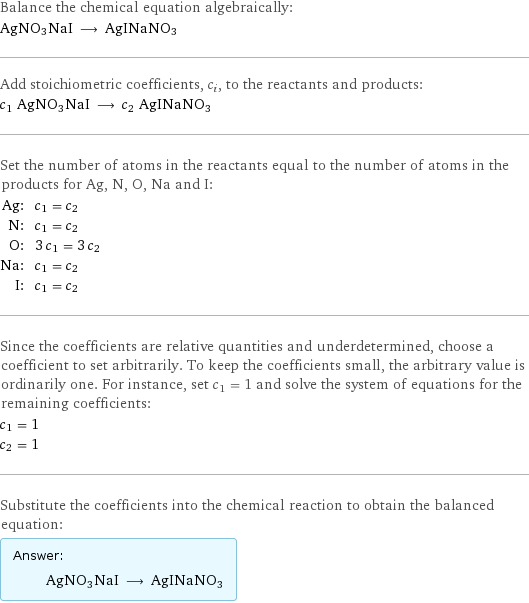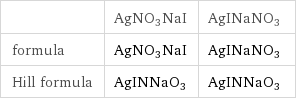Input interpretation

AgNO3NaI ⟶ AgINaNO3
Balanced equation

Balance the chemical equation algebraically: AgNO3NaI ⟶ AgINaNO3 Add stoichiometric coefficients, c_i, to the reactants and products: c_1 AgNO3NaI ⟶ c_2 AgINaNO3 Set the number of atoms in the reactants equal to the number of atoms in the products for Ag, N, O, Na and I: Ag: | c_1 = c_2 N: | c_1 = c_2 O: | 3 c_1 = 3 c_2 Na: | c_1 = c_2 I: | c_1 = c_2 Since the coefficients are relative quantities and underdetermined, choose a coefficient to set arbitrarily. To keep the coefficients small, the arbitrary value is ordinarily one. For instance, set c_1 = 1 and solve the system of equations for the remaining coefficients: c_1 = 1 c_2 = 1 Substitute the coefficients into the chemical reaction to obtain the balanced equation: Answer: | | AgNO3NaI ⟶ AgINaNO3
Structures

AgNO3NaI ⟶ AgINaNO3
Names

AgNO3NaI ⟶ AgINaNO3
Equilibrium constant
![Construct the equilibrium constant, K, expression for: AgNO3NaI ⟶ AgINaNO3 Plan: • Balance the chemical equation. • Determine the stoichiometric numbers. • Assemble the activity expression for each chemical species. • Use the activity expressions to build the equilibrium constant expression. Write the balanced chemical equation: AgNO3NaI ⟶ AgINaNO3 Assign stoichiometric numbers, ν_i, using the stoichiometric coefficients, c_i, from the balanced chemical equation in the following manner: ν_i = -c_i for reactants and ν_i = c_i for products: chemical species | c_i | ν_i AgNO3NaI | 1 | -1 AgINaNO3 | 1 | 1 Assemble the activity expressions accounting for the state of matter and ν_i: chemical species | c_i | ν_i | activity expression AgNO3NaI | 1 | -1 | ([AgNO3NaI])^(-1) AgINaNO3 | 1 | 1 | [AgINaNO3] The equilibrium constant symbol in the concentration basis is: K_c Mulitply the activity expressions to arrive at the K_c expression: Answer: | | K_c = ([AgNO3NaI])^(-1) [AgINaNO3] = ([AgINaNO3])/([AgNO3NaI])](../image_source/2dde075136fb630f974634c8951de8b2.png)
Construct the equilibrium constant, K, expression for: AgNO3NaI ⟶ AgINaNO3 Plan: • Balance the chemical equation. • Determine the stoichiometric numbers. • Assemble the activity expression for each chemical species. • Use the activity expressions to build the equilibrium constant expression. Write the balanced chemical equation: AgNO3NaI ⟶ AgINaNO3 Assign stoichiometric numbers, ν_i, using the stoichiometric coefficients, c_i, from the balanced chemical equation in the following manner: ν_i = -c_i for reactants and ν_i = c_i for products: chemical species | c_i | ν_i AgNO3NaI | 1 | -1 AgINaNO3 | 1 | 1 Assemble the activity expressions accounting for the state of matter and ν_i: chemical species | c_i | ν_i | activity expression AgNO3NaI | 1 | -1 | ([AgNO3NaI])^(-1) AgINaNO3 | 1 | 1 | [AgINaNO3] The equilibrium constant symbol in the concentration basis is: K_c Mulitply the activity expressions to arrive at the K_c expression: Answer: | | K_c = ([AgNO3NaI])^(-1) [AgINaNO3] = ([AgINaNO3])/([AgNO3NaI])
Rate of reaction
![Construct the rate of reaction expression for: AgNO3NaI ⟶ AgINaNO3 Plan: • Balance the chemical equation. • Determine the stoichiometric numbers. • Assemble the rate term for each chemical species. • Write the rate of reaction expression. Write the balanced chemical equation: AgNO3NaI ⟶ AgINaNO3 Assign stoichiometric numbers, ν_i, using the stoichiometric coefficients, c_i, from the balanced chemical equation in the following manner: ν_i = -c_i for reactants and ν_i = c_i for products: chemical species | c_i | ν_i AgNO3NaI | 1 | -1 AgINaNO3 | 1 | 1 The rate term for each chemical species, B_i, is 1/ν_i(Δ[B_i])/(Δt) where [B_i] is the amount concentration and t is time: chemical species | c_i | ν_i | rate term AgNO3NaI | 1 | -1 | -(Δ[AgNO3NaI])/(Δt) AgINaNO3 | 1 | 1 | (Δ[AgINaNO3])/(Δt) (for infinitesimal rate of change, replace Δ with d) Set the rate terms equal to each other to arrive at the rate expression: Answer: | | rate = -(Δ[AgNO3NaI])/(Δt) = (Δ[AgINaNO3])/(Δt) (assuming constant volume and no accumulation of intermediates or side products)](../image_source/55545f242e036aa351be530ec83edac1.png)
Construct the rate of reaction expression for: AgNO3NaI ⟶ AgINaNO3 Plan: • Balance the chemical equation. • Determine the stoichiometric numbers. • Assemble the rate term for each chemical species. • Write the rate of reaction expression. Write the balanced chemical equation: AgNO3NaI ⟶ AgINaNO3 Assign stoichiometric numbers, ν_i, using the stoichiometric coefficients, c_i, from the balanced chemical equation in the following manner: ν_i = -c_i for reactants and ν_i = c_i for products: chemical species | c_i | ν_i AgNO3NaI | 1 | -1 AgINaNO3 | 1 | 1 The rate term for each chemical species, B_i, is 1/ν_i(Δ[B_i])/(Δt) where [B_i] is the amount concentration and t is time: chemical species | c_i | ν_i | rate term AgNO3NaI | 1 | -1 | -(Δ[AgNO3NaI])/(Δt) AgINaNO3 | 1 | 1 | (Δ[AgINaNO3])/(Δt) (for infinitesimal rate of change, replace Δ with d) Set the rate terms equal to each other to arrive at the rate expression: Answer: | | rate = -(Δ[AgNO3NaI])/(Δt) = (Δ[AgINaNO3])/(Δt) (assuming constant volume and no accumulation of intermediates or side products)
Chemical names and formulas

| AgNO3NaI | AgINaNO3 formula | AgNO3NaI | AgINaNO3 Hill formula | AgINNaO3 | AgINNaO3
Substance properties

| AgNO3NaI | AgINaNO3 molar mass | 319.766 g/mol | 319.766 g/mol
Units
